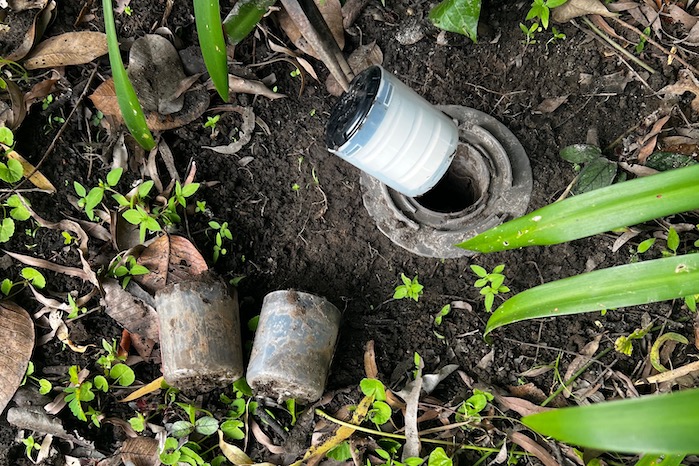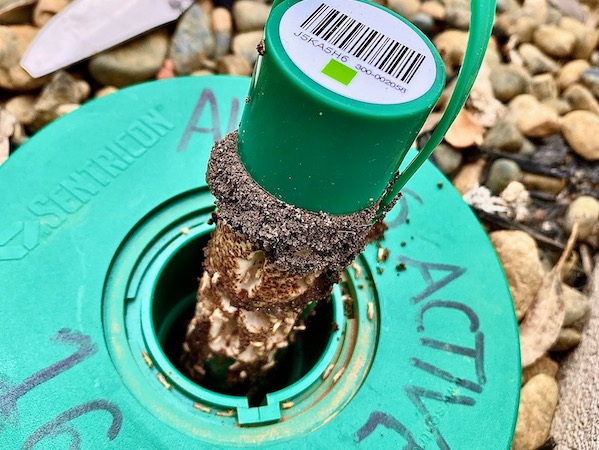Termite baits are the smart way to control termites as they tap into the termites’ natural behaviours and actually eliminate the nest (colony).
Termite nests are hard to locate, as they are often hidden underground. In termite control, it’s important to try and eliminate the nest, as it puts a permanent end to the threat from that colony, reducing the termite pressure on the property. By using baits, there is no need to actually find the nest – the baits are placed where termites are foraging. If the bait is attractive, they will take the bait back to the nest and feed it to their nest mates.
What’s in a termite bait?
Termite baits contain a food that’s attractive to termites (cellulose) and a special slow acting insecticide. Cellulose is one of the key components in wood (which of course termites love!) and it’s important that the bait is very attractive to the termites so that they find it, take it back to the nest and feed it to their nest mates. The insecticide needs to be slow acting, so the termites cannot detect that it’s causing them harm, allowing them to spread the bait around the nest.
How do termite baits kill termites?
The special slow acting insecticide does not kill the termites straight away after eating the bait. Instead, the insecticide stops the termite moulting its cuticle (skin) properly, which it needs to do on regular basis as it ages. When it tries to moult, it fails and dies in the process.

How do termite baits eliminate the colony?
Termites only moult every couple of months. So, how quickly an individual termite dies depends on when they are next due to moult. It may be a week; it may be a couple of months. However, as soon as the queen eats the bait, she effectively becomes sterilised, and the colony is doomed. The young larvae in the nest moult more frequency and so die more quickly. As the level of mortality increases over time, the nest can no longer look after itself properly and the colony collapses due to its inability to feed itself and from disease.
How long do baits take to work?
Termites moult more quickly in warmer temperatures and therefore the time of year the baiting treatment is carried out, impacts the speed in which the colony is eliminated. It takes around 3 months to eliminate a colony in summer and up to 6 months during the cooler months.
Types of termite baiting and monitoring systems
There are different types of baits and termite baiting and monitoring systems…
When trying to eliminate active termite from a building, termite bait is placed in bait stations which are fixed to the areas inside the home where the termites are feeding. They then take the bait back to the nest which is attacking the home.
To use termite baits to provide the long-term protection for the building, bait stations need to be installed in the ground at regular intervals around the perimeter of the property. There are two types of these in-ground baiting systems:
- Termite monitoring and baiting systems: These systems use wood in the bait stations to monitor for termite activity. If termite activity is detected during one of the regular inspections, termite bait is then added to the bait station to eliminate the colony.
- Permanent termite baiting systems: These systems have termite bait in the bait stations all the time (from installation), so the system is continually working to protect your home. Fumapest use these newer systems, as they ensure the product is always working to protect your home even between inspections. Termites VIC only use one of the two leading products, either Trelona Termite Bait or Sentricon AlwaysActive.


Regular inspections are important
As with any termite management system, annual termite inspections on the whole property (and building) are required each year to maintain the warranty. With termite baiting systems, it is normal to also check the baits every 3 months to check for activity and make sure sufficient bait is available.
Which is better, a termite baiting system or a termite soil treatment?
At Termites VIC we use both termite baiting systems and termite soil treatments to protect properties. Whereas at many properties you can choose which system to install, at some properties it may be better to install one type of system over the other, due to the termite species present, the soil type or the building construction.
Generally speaking, soil treatments are more expensive to install, but cheaper to maintain, whereas termite baiting systems are cheaper to install but more expensive to maintain. At Termites VIC, whenever we provide a quote, we will take you through all the termite treatment options so you can make an informed choice for your particular situation.
For more information on termite treatments in Melbourne…
